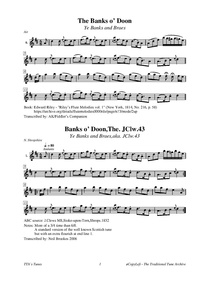Template:Pagina principale/Vetrina

How can ye bloom sae fresh and fair?
How can ye chaunt, ye little birds,
And I’m sae wearyful O’ care?
Played by: John Daddio Clarke
Source: Soundcloud
Image: The Auld Brig o' Doon

The antiquarian William Chappell claims the tune is English on the strength of its being included in a Collection of English Songs by Dale (who published about 1780-1794) under the title "Lost is my quiet."
However, the collector John Glen (1891) relates a delightful story of the tune's origins involving the famous Scots poet, Robert Burns (1759-1796), who wrote to publisher George Thomson in 1794:
Do you known the history of the air? It is curious enough. A good many years ago, Mr. James Miller, writer in your good own (Edinburgh), a gentleman whom, possibly, you know, was in company with our good friend Clarke; and taling of Scottish music, Miller expressed an ardent ambition to be able to compose a Scots air. Mr. Clarke, partly by way of a joke, told him to keep to the black keys of the harpsichord, and preserve some kind of rhythm, and he would infallibly compose a Scots air. Certain it is, that, in a few days, Mr. Miller produced the rudiments of an air which Mr. Clarke, with some touches and corrections, fashioned into the tune in question. Ritson, you know, has the same story of the black keys; but this account which I have just given you, Mr. Clarke informed me of several years ago.
...more at: Ye Banks and Braes - full Score(s) and Annotations
X: 1 T:Banks o' Doon,The. JClw.43 T:Ye Banks and Braes,aka. JClw.43 M:6/8 L:1/8 Q:3/8=80 S:J.Clews MS,Stoke-upon-Tern,Shrops.1832 N:More of a 3/4 time than 6/8. N:A standard version of the well known Scottish tune N:but with an extra flourish at end line 1. A:N. Shropshire Z:Neil Brookes 2006 K:D V:1 clef=treble name="1." [V:1] "^Andante"A|d2d {f}e>de|f>af {f}e>de|{de}f>e.d d>B.A|Adf b/a/=g/b/g/e/|! d2d{f}e>de|f>af {f}e>de|{de}f>e.d d>B.A|A>Bc{e}d2:|! |:d/f/|a2b afd|a2b afd|afd afd|baf e2A|! d2d {f}e>de|f>af {f}e>de|{de}f>e.d d>B.A|A>Bc{e}d2:|
